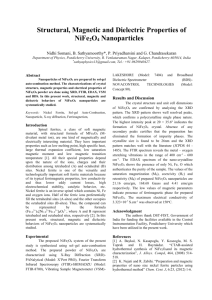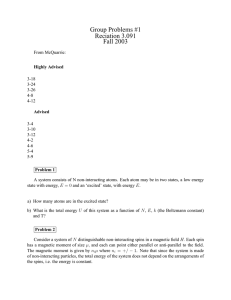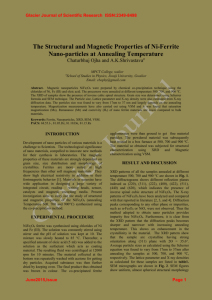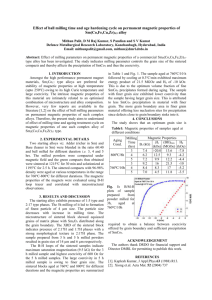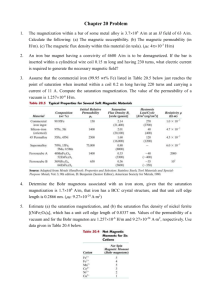!eel temperature and magnetic Grain size effect on the N O
advertisement
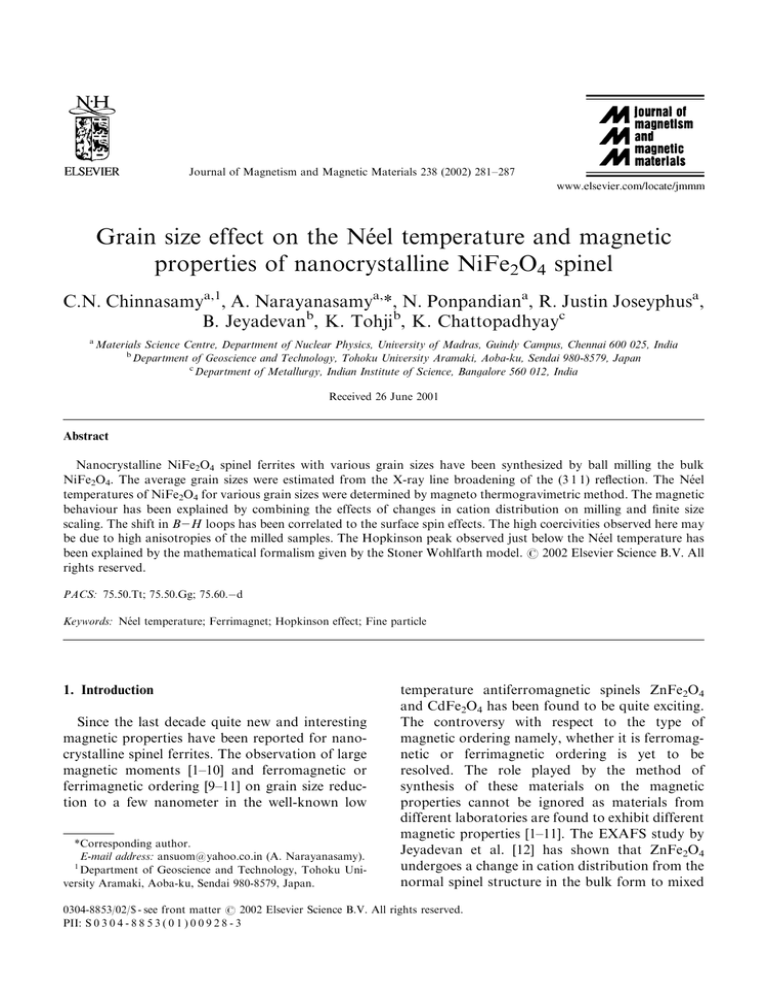
Journal of Magnetism and Magnetic Materials 238 (2002) 281–287 Grain size effect on the Ne! el temperature and magnetic properties of nanocrystalline NiFe2O4 spinel C.N. Chinnasamya,1, A. Narayanasamya,*, N. Ponpandiana, R. Justin Joseyphusa, B. Jeyadevanb, K. Tohjib, K. Chattopadhyayc a Materials Science Centre, Department of Nuclear Physics, University of Madras, Guindy Campus, Chennai 600 025, India b Department of Geoscience and Technology, Tohoku University Aramaki, Aoba-ku, Sendai 980-8579, Japan c Department of Metallurgy, Indian Institute of Science, Bangalore 560 012, India Received 26 June 2001 Abstract Nanocrystalline NiFe2O4 spinel ferrites with various grain sizes have been synthesized by ball milling the bulk NiFe2O4. The average grain sizes were estimated from the X-ray line broadening of the (3 1 1) reflection. The N!eel temperatures of NiFe2O4 for various grain sizes were determined by magneto thermogravimetric method. The magnetic behaviour has been explained by combining the effects of changes in cation distribution on milling and finite size scaling. The shift in B2H loops has been correlated to the surface spin effects. The high coercivities observed here may be due to high anisotropies of the milled samples. The Hopkinson peak observed just below the N!eel temperature has been explained by the mathematical formalism given by the Stoner Wohlfarth model. r 2002 Elsevier Science B.V. All rights reserved. PACS: 75.50.Tt; 75.50.Gg; 75.60.d Keywords: N!eel temperature; Ferrimagnet; Hopkinson effect; Fine particle 1. Introduction Since the last decade quite new and interesting magnetic properties have been reported for nanocrystalline spinel ferrites. The observation of large magnetic moments [1–10] and ferromagnetic or ferrimagnetic ordering [9–11] on grain size reduction to a few nanometer in the well-known low *Corresponding author. E-mail address: ansuom@yahoo.co.in (A. Narayanasamy). 1 Department of Geoscience and Technology, Tohoku University Aramaki, Aoba-ku, Sendai 980-8579, Japan. temperature antiferromagnetic spinels ZnFe2O4 and CdFe2O4 has been found to be quite exciting. The controversy with respect to the type of magnetic ordering namely, whether it is ferromagnetic or ferrimagnetic ordering is yet to be resolved. The role played by the method of synthesis of these materials on the magnetic properties cannot be ignored as materials from different laboratories are found to exhibit different magnetic properties [1–11]. The EXAFS study by Jeyadevan et al. [12] has shown that ZnFe2O4 undergoes a change in cation distribution from the normal spinel structure in the bulk form to mixed 0304-8853/02/$ - see front matter r 2002 Elsevier Science B.V. All rights reserved. PII: S 0 3 0 4 - 8 8 5 3 ( 0 1 ) 0 0 9 2 8 - 3 282 C.N. Chinnasamy et al. / Journal of Magnetism and Magnetic Materials 238 (2002) 281–287 spinel structure in the nanocrystalline form. Nanocrystalline NiFe2O4 spinel is another such system which has been extensively studied by . Mossbauer and magnetization techniques [13,14]. Recently, we have shown that nanocrystalline NiFe2O4 exhibits mixed spinel structure whereas in the bulk form it is a well-known inverse spinel with all Ni2+ ions on the B-sites and Fe3+ ions equally distributed between A- and B- sites [15]. Our study has shown that the ball milled NiFe2O4 with a grain size of 60 nm is a mixed spinel with about four percent Ni2+ ions occupying the Asites. Also, the magnetization of NiFe2O4 spinel with grain size of 60 nm has been enhanced by 8% from its bulk value. Chen et al. [16] have reported changes in cation distribution and a decrease in Ne! el temperature in MnFe2O4 as grain size is decreased. The decrease in Ne! el temperature has been found to be consistent with the finite size scaling. To our knowledge, this is the only spinel ferrite for which the grain size dependent Ne! el temperature has been reported. In the present study, we report the effect of grain size on Ne! el temperature in the case of NiFe2O4 spinel and also its effect on the magnetic properties such as saturation magnetization, coercivity and B2H loop-shifts, etc. The coercivity reported in this paper is found to be the highest of all the values reported so far for the ultrafine particles of NiFe2O4. Sample Magnetometer from 4 to 300 K in a magnetic field of 1 T. The zero field-cooled (ZFC) magnetization data were obtained by cooling the sample to 4 K in zero field and then recording the B2H loops in 1 T field at the interval of 10 K till 300 K. The field-cooled (FC) magnetization data were obtained from the B2H loops measured at 10 K interval while cooling the sample from 300 to 4 K in the presence of 1 T field. 3. Results and discussion 3.1. Grain size, root mean square (r.m.s.) strain and lattice parameter The average grain size was determined from the line width of the reflection (3 1 1) in XRD patterns using Scherrer formula. The variation of average grain size with milling time is shown in Fig. 1. The grain size decreases with milling time and reaches 10 nm for the 30 h milled sample. The r.m.s. strain was calculated by using the relation [17] b ¼ 2Z/e2 S1=2 tan y; ð1Þ where b is the full-width at half-maximum of the X-ray Bragg peak and Z is the coefficient which depends on the distribution of strains, /e2S1/2 is 60 Polycrystalline nickel ferrite was synthesized by the conventional ceramic method and samples of various grain sizes were obtained by high energy ball milling in a planetary ball mill (Fritsch Pulverisette, P7) as reported earlier [15]. The formation of spinel phase was confirmed from X-ray powder diffraction measurements. Magnetic force measurements were carried out as a function of temperature with a thermogravimetric analyser (TGA, Perkin-Elmer series 7) using a small permanent magnet to determine the Ne! el temperature for various grain sizes. The samples were heated at a rate of 101C/min. Magnetization measurements were performed with a Vibrating Average grain size (nm) 2. Experimental 50 40 30 20 10 0 5 10 15 20 25 30 Milling time (h) Fig. 1. Variation of average grain size of nanostructured NiFe2O4 with milling time. The continuous line is guide to the eye. C.N. Chinnasamy et al. / Journal of Magnetism and Magnetic Materials 238 (2002) 281–287 the r.m.s. strain and y is the diffraction angle and the values are plotted in Fig. 2 as a function of milling time. The increase in r.m.s. strain with milling is due to the increasing defect density. The lattice parameter as seen from Fig. 3 is higher for the milled samples than for the as-prepared one. This is in agreement with the findings of Sato et al. [18]. The increase in lattice parameter could be due to the deviation in cation distribution from the inverse spinel structure of the milled NiFe2O4 as confirmed from our EXAFS and in-field . Mossbauer measurements [15]. 0.25 r.m.s. strain (%) 0.20 0.15 0.10 0.05 0 5 10 15 20 25 30 Milling time (h) Fig. 2. The r.m.s. strain versus milling time for NiFe2O4. 283 3.2. N!eel temperature versus grain size The Ne! el temperatures estimated from the thermogravimetric measurements for the NiFe2O4 samples with various grain sizes are shown in Fig. 4. As seen from the figure, the values of Ne! el temperatures of the milled samples are found to be greater than that of the reported value of 858 K for the bulk sample [19]. It increased with milling upto 6 h and thereafter it decreased with further milling. The decrease in the value of Ne! el temperature with grain size reduction in the case of MnFe2O4 has been explained on the basis of the finite size effects [16]. Similarly, the decrease in TN with grain size at higher milling times for NiFe2O4 could be explained on the basis of the finite size scaling theory as seen from Fig. 5. According to this theory, the shift in the Ne! el temperature from that of the bulk is given by 1=n TN ðdÞ TN ðbulkÞ d ¼ ; ð2Þ TN ðbulkÞ d0 where TN ðdÞ is the Ne! el temperature for a given particle size d; TN (bulk) is the Ne! el temperature of the bulk sample, d0 is a constant and n is the critical exponent of the correlation lengths. The straight line in Fig. 5 is obtained as a result of fitting the experimental data using Eq. (2). The parameters obtained from the best fit were TN ðbulkÞ ¼ 89373 K; 0.8360 12 h Neel Temperature (TN) K 890 0.8355 a (nm) 0.8350 0.8345 0.8340 6h 20 h 1h 880 870 30 h 860 0.8335 0 5 10 15 20 25 30 Milling Time (h) Fig. 3. The lattice parameter of the nanostructured NiFe2O4 as a function of milling time. Bulk (micron size) 0 20 40 60 80 100 Average Grain size (nm) Fig. 4. N!eel temperature versus average grain size for nanostructured NiFe2O4. The continuous line is guide to the eye. C.N. Chinnasamy et al. / Journal of Magnetism and Magnetic Materials 238 (2002) 281–287 284 measurements reported earlier [15]. The small particles have a significant fraction of atoms on the surface and their exchange interaction should be weaker because of the lower coordination and hence they will have a reduced average Ne! el temperature compared to that of the interior atoms. This will account for the decrease in TN for higher milling times. 895 TN (K) 890 885 880 875 870 865 0.000 0.002 0.004 0.006 0.008 0.010 0.012 (1/d) 1/ ν -1 nm Fig. 5. Finite size scaling analysis of N!eel temperature versus grain size. Solid line is obtained by fitting the data for the samples milled for 6, 12, 20 and 30 h. n ¼ 0:570:1; d0 ¼ 1:670:1 nm: The higher value for TN ðbulkÞ obtained through the fitting compared to the value of 858 K obtained for micron size NiFe2O4 particles [19] indicates that the change in cation distribution in the present samples has increased the net super exchange interaction strength as has been observed in the case of MnFe2O4 [16]. The variation in Ne! el temperature of NiFe2O4 with grain size can be qualitatively explained by combining the effect of change in cation distributions and finite size effects. The increase in the value of TN for the initial stages of milling (1 and 6 h) is due to the predominance of the effect due to change in cation distribution over the finite size effect on Ne! el temperature. We have reported earlier that Ni2+ ions occupy the tetrahedral sites in NiFe2O4 when ball milled [15]. The exchange constants for the Ni–Ni and Ni–Fe interactions in the A-sites are not available in the literature to quantitatively account for the variation of Ne! el temperature with change in cation distribution. The finite size effect should be predominant over the influence of the change in cation distribution when the grain sizes are very small (for prolonged milling time) which results in a decrease in TN with grain size reduction. The surface effects were dominant for the 20 and 30 h milled samples as confirmed from . our Mossbauer and high field magnetization 3.3. Temperature dependence of magnetization and coercivity The saturation magnetization and remanence of the 20 h milled (15 nm) NiFe2O4 sample determined in an applied magnetic field of 1 T increases on cooling from 300 to 150 K but on further cooling it decreases both in the case of ZFC and FC states as seen from Fig. 6. This is a clear Fig. 6. ZFC and FC curves for the 20 h milled (15 nm) NiFe2O4 in 1 T applied field versus temperature (a) for magnetisation and (b) for remanence. C.N. Chinnasamy et al. / Journal of Magnetism and Magnetic Materials 238 (2002) 281–287 evidence for the spin canting. A field of 1 T was found to be small to turn all the spins along the field direction as is evident from the decrease of magnetization below 150 K. The coercivity was found to be 0.22 T at 5 K and it decreased to 0.13 T at 300 K as seen from Fig. 7. Magnetocrystalline anisotropy, surface anisotropy and shape anisotropy may all contribute to such a high coercivity of ultrafine particles. The hysteresis loop shift was also observed and its value in the FC state for the 1 T applied field is plotted in Fig. 7 as a function of temperature. The similar temperature dependence of coercivity and the loop shift suggested that the core spins were strongly coupled to the disordered surface spins. The observed loop shift can be understood as explained already by Kodama et al. [14]. Ferrimagnetic ordering in spinel ferrites arises due to the intersublattice (A–O–B) super exchange interaction being stronger than the intrasublattice (A–O–A or B–O–B) super exchange interactions. Since the surface cations have a reduced and also a distributed coordination, the exchange fields are also distributed. As the super exchange interactions take place through an intervening O2 ion, exchange bonds will be broken if an O2 ion is missing from the surface. Also, the surface spins have multiple configurations, i.e. randomly oriented spin directions. Due to the exchange coupling between the surface and core spins, field 285 cooling can select a particular surface spin configuration which favours the particle being magnetized in the FC direction resulting in a shifted hysteresis loop. 3.4. Hopkinson effect The thermomagnetic curves obtained in a magnetic field of 4 mT for the NiFe2O4 sample with a grain size of 15 nm are presented in Fig. 8 both for the as-milled sample and for the same sample for a second run. For the virgin sample the magnetization increases with temperature close to the Ne! el temperature, T N and have a well-defined maximum just below the Ne! el temperature. The shape of the curve shows the characteristic peculiarities of the Hopkinson effect [20–22]. However, for the second run the magnetization decreases monotonically with temperature. The increase in the magnetization close to TN during the first run may, therefore, be due to the Hopkinson effect as has been observed in the case of nanostructured NiFe2O4 particles synthesized by the citrate precursor technique [23]. Hopkinson effect is observed in nanocrystalline single domain NiFe2O4 particles where the size of the paticles is 0.25 Coercivity Loop Shift H (T) 0.20 0.15 0.10 0.05 0.00 0 50 100 150 200 250 300 Temperature (K) Fig. 7. Coercivity and loop shift versus temperature for the 20 h milled (15 nm) NiFe2O4 sample in the FC state. The continuous line is guide to the eye. Fig. 8. Thermomagnetic plot for the 20 h milled (15 nm) nanostructured NiFe2O4: (a) as-milled powder and (b) rerun for the same sample. 286 C.N. Chinnasamy et al. / Journal of Magnetism and Magnetic Materials 238 (2002) 281–287 neither very small to be superparamagnetic nor very large to be of multidomain nature [24]. The existence of the Hopkinson effect in the NiFe2O4 single domain particles can be explained within the framework of the Stoner Wohlfarth model [25]. The magnetization of a randomly oriented system in a small magnetic field, H is 2 H MSW ðTÞ ¼ rMS ðTÞ ; 3 Ha ðTÞ ð3Þ where MS ðTÞ is the bulk saturation magnetization, Ha ðTÞ is the anisotropy field of the particles at the temperature T and r is the packing fraction of the powder. When the field H is small, Ha decreases much faster than MS with temperature and hence there is an overall increase in magnetization which attains a maximum just below TN : Because both MS and Ha decrease with increasing T; this competition may result in a maximum of magnetization, the result is Hopkinson peak. At temperatures far from TN ; Ha is predominant. During the heating run, near TN ; Ha ðTÞ decreasing much faster than Ms ðTÞ and becoming very weak, the magnetic moments of the particles tend to align themselves nearer to H direction. This competitive effect results in a gradual rise of over all magnetization and MSW ðTÞ shows a steep rise just below TN since Ha ðTÞ becomes almost zero. Further increase of temperature causes demagnetization and magnetization value approaches to zero at the Ne! el temperature TN : Since the magnetic moments are already aligned along the field direction due to reduction in Ha during heating in the first run itself, the magnetization decreases monotonically with temperature during the second run. 4. Conclusion The Ne! el temperatures of the ball milled nanocrystalline NiFe2O4 spinel ferrites are found to be greater than that of the bulk NiFe2O4. The variation of the Ne! el temperature with grain size has been explained on the basis of finite size effects and changes in cation distributions. The observed hysteresis loop shift has been attributed to the canting of surface spins and possible multiple surface spin configurations. The Hopkinson effect was explained within the framework of the mathematical formalism given by Stoner Wohlfarth. Acknowledgements The financial assistance from UGC-SAP (PhaseIII) and UGC Major Research Project (F.10-32/ 98(SR-I)) sanctioned to the University of Madras is gratefully acknowledged. The authors would like to thank Dr. R. Krishnan for fruitful discussions. Two of us (CNC and NP) would like to thank the Council of Scientific and Industrial Research, Government of India for the award of senior research fellowship. References [1] W. Schissel, W. Potzel, H. Karzel, M. Steiner, G.M. Kalvius, A. Martin, M.K. Karause, I. Halevy, J. Gal, W. Sch.afer, R. W.appling, Phys. Rev. B 53 (1996) 9143. [2] H.H. Hamdeh, J.C. Ho, S.A. Oliver, R.J. Wiley, G. Oliveri, G. Busca, J. Appl. Phys. 81 (1997) 1851. [3] M. Clark Ted, B.J. Evans, IEEE Trans. Magn. 33 (1997) 3745. [4] M. Yokayama, E. Ohta, T. Sato, T. Komaba, T. Sato, J. Phys. Coll. IV 7C1 (1997) 521. [5] J. Battle, T. Clark, B.J. Evans, J. Phys. Coll. IV 7C1 (1997) 257. [6] H.H. Hamdeh, J.C. Ho, S.A. Oliver, R.J. Wiley, J. Kramer, Y.Y. Chen, S.H. Lin, Y.D. Yao, M. Datiro, G. Busca, IEEE Trans. Magn. 31 (1995) 3808. [7] T. Sato, K. Haneda, M. Seki, T. Iijima, Appl. Phys. A 50 (1990) 13. [8] M.R. Anantharaman, S. Jagatheesan, K.A. Malini, S. Sindhu, A. Narayanasamy, C.N. Chinnasamy, J.P. Jacips, S. Reijne, H. Seshan, R.H.H. Brongersma, J. Magn. Magn. Mater. 189 (1998) 83. [9] F.J. Burghart, W. Potzel, G.M. Kalvius, E. Schreier, G. Grosse, D.R. Noakes, W. Sch.afer, W. Kockelmann, S.J. Campbell, W.A. Kaczmarek, A. Martin, M.K. Krause, Physica B 289–290 (2000) 286. [10] C.N. Chinnasamy, A. Narayansamy, N. Ponpandian, K. Chattopadhyay, H. Gu!erault, J.-M. Greneche, J. Phys.: Condens. Matter 12 (2000) 7795. [11] C.N. Chinnasamy, A. Narayanasamy, N. Ponpandian, R. Justin Joseyphus, K. Chattopadhyay, K. Shinoda, B. Jeyadevan, K. Tohji, K. Nakatsuka, J.-M. Greneche, J. Appl. Phys. 90 (2001) 527. C.N. Chinnasamy et al. / Journal of Magnetism and Magnetic Materials 238 (2002) 281–287 [12] B. Jeyadevan, K. Tohji, K. Nakatsuka, J. Appl. Phys. 76 (1994) 6325. [13] A.H. Morrish, K. Haneda, J. Appl. Phys. 52 (1981) 2496. [14] R.H. Kodama, A.E. Berkowitz, Phys. Rev. B 59 (1999) 6321. [15] C.N. Chinnasamy, A. Narayanasamy, N. Ponpandian, K. Chattopadhyay, K. Shinoda, B. Jeyadevan, K. Tohji, K. Nakatsuka, T. Furubayashi, I. Nakatani, Phys. Rev. B 63 (2001) 184108. [16] J.P. Chen, C.M. Sorenson, K.J. Klabunde, G.C. Hadjipanayis, E. Devilin, A. Kostikas, Phys. Rev. B 54 (1996) 9288. [17] D. Olezak, Mater. Sci. Eng. A 181/182 (1994) 121. [18] T. Sato, T. Iijima, M. Seki, N. Inagaki, J. Magn. Magn. Mater. 65 (1987) 252. 287 [19] J. Smith, H.P.J. Wijn, Ferrites, Philips Technical Library, Eindhoven, The Netherlands, 1959, p. 157. [20] J. Hopkinson, Proc. R. Soc. London 48 (1890) 1. [21] O. Popov, P. Rachev, M. Mikhov, F. Calderon, J.L. Sanchez, F. Leccabue, J. Magn. Magn. Mater. 99 (1991) 119. [22] O. Popov, M. Mikhov, J. Magn. Magn. Mater. 82 (1989) 29. [23] S. Prasad, N.S. Gajbhioe, J. Alloys Compds. 265 (1998) 87. [24] N.S. Gajbhiye, S. Prasad, G. Balaji, IEEE Trans. Magn. 35 (1999) 2155. [25] E.C. Stoner, E.P. Wohlfarth, Phil. Trans. Roy. Soc. A 240 (1948) 599.
